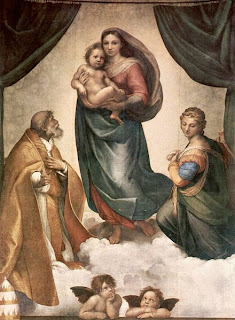When Daisy Gordon was in her early twenties, she traveled to Europe. The European tour was considered culturally enlightening, and those families who could afford it sent their daughters as a sort of capstone educational experience. Such a trip would introduce young women to the major tourist sites, broaden their experiences, and make them more knowledgeable citizens. The possibility of meeting a potential husband was another, usually exciting, reason to go, too. The reality of the European tour for most women was that it was the last time they would travel before children and homemaking tied them to the United States.
As a budding artist, with a sister who had already been, it was Daisy’s turn for the trans-Atlantic journey in 1882. Hers was an uncharacteristically brief trip, and she had a secret and ulterior motive for going (more on that in future posts) so she was rather distracted, but she slowed down enough to really see the art she encountered. When a friend of hers named Mary went to Europe a year later, Daisy wrote her a reflective letter, suggesting which paintings were worth seeing and noting her personal favorites:
 |
| Caravaggio’s “Rest on the Flight into Egypt, “c. 1597 |
Daisy liked all of Caravaggio’s work, and she enthused especially about the way he had so beautifully rendered Mary’s hair in this painting.
 |
| Dolci’s “St. Cecilia at the Organ,” 1671 |
Carlo Dolci (or Dolce) was a particular favorite, and she mentioned by name several of his paintings, including this one of St. Cecilia, the patron saint of music. Dolci (or one of his students) also painted “The Virgin and Child with Flowers,” a copy of which hung over Mary’s prie-dieu, and Daisy knew it well from seeing it at her house.
 |
| Raphael’s “Sistine Madonna,” c. 1513 |
This painting is more famous to us today for the cherubs, but Daisy didn’t mention them. She wrote that she “couldn’t help being carried away by the virgin’s face,” but she really disliked Raphael’s rendition of the infant Jesus, because she thought he looked “wall-eyed.” Her sister Eleanor believed the more one contemplated this painting, the more one would like it, but Daisy didn’t think so!
 |
| Reni’s “St. Michael the Archangel, “1636 |
Daisy cautioned Mary to appreciate the “best style” of Guido Reni. He apparently painted with two different styles–one when sober and one when inebriated. Daisy puckishly admitted she was “mortified to learn that I liked the wrong style best and thought he succeeded better when drunk.” Whether this is Reni drunk or Reni sober, I confess I don’t know.
.jpg) |
| Titian’s “The Tribute Money,” mid-16th century |
Of all the paintings Daisy mentioned (and there were more than I’ve posted here) the one she most admired was Titian’s “The Tribute Money.” It tells the New Testament story of the Pharisees challenging Jesus and asking to whom they should pay their taxes. Daisy was a strong Episcopalian and she knew her Bible. Titian’s depiction evoked an emotional response from her, and more–it challenged her conception of Jesus: “…I have always thought of our Lord as a fair man and that picture…represents him dark, but the holiness the unearthly loveliness and reproach of that face, made me forget coloring and feel that nothing could have more completely represented him. I could almost hear his patient inquiry (not scornful nor triumphant because he saw through his questioner, but only patient), ‘Show me a penny. Whose image and superscription hath it?’”
Daisy’s tastes ranged beyond religious works from the Renaissance. She mentioned liking some paintings from the “new, modern” section in a Dresden museum in Dresden. These might have been as late as the early nineteenth century, and her descriptions are of clearly secular topics.
As an historical biographer, it’s important to me to understand as much as I can about Daisy Low’s world–her exterior world and her interior world–and knowing the sort of art she admired is a crucial key.


Fascinating. What if women such as Daisy found a partner in Europe? What then? How did they work through the cultural differences? Where did they settle?
Hi! Thanks so much for your comment. It was not uncommon for upper-class Americans to seek out wealthy Europeans–and vice versa. Those were often the celebrity marriages of their day, and the cause for great celebration (see, we ARE as good as them) and great bitterness (what's the matter with American men?). Theodore Roosevelt absolutely forbade his daughters to marry Europeans after a spate of high-profile weddings in which young Americans were forced by their grasping parents to marry rich, older or dissolute Europeans. But you may know that Daisy married a European, and so did her sister Mabel. They both lived in Europe, although Daisy kept the home in Savannah. The cultural differences weren't that vast, as both men were British. While some trans-Atlantic marriages flourished, others didn't–sometimes because of cultural differences but mostly for all the many reasons other marriages fail.
I am looking forward to reading your book when it comes out. Does your book talk at all about some of her favorites? I am specifically looking to find out if there were any favorite drinks or foods, espically fruits that she liked.
Thanks for your comment! I don't recall any mention of favorite foods, Candis; I'm sorry. It wasn't a topic that turned up much. I'll think about it during the revisions for the book manuscript, though.